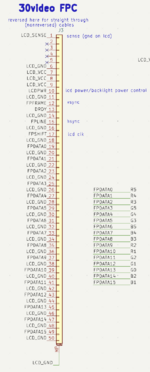Three weird questions I'm curious about:
1. Possiblilty of LVDS/eDP support to use another type of panel?
2. Possibility of shoving a slight larger screen (e.g. 10.5", 1600x1200) and cropping it to 8.4" size (1280x960 aka 640x480 pixel doubled)? I think physically it'd fit, so more a question of what kind of scaler logic would be necessary to take in the video output and enable that crop factor on screen. I have a very specific panel in mind from a tablet I worked on that would be a cool new spin on the classic mac experience, but this is also essentially asking a question about the high res iPad panels since I believe they're eDP and would need pixel doubling & some crop factor if inserted in.
3. Similar idea, possibility of inserting some kit that would apply CRT shaders between the card and the screen? This is more just a fun step I'd love to see happen in this project!
Thanks
This would require a FPGA with enough built in SRAM to capture the incoming parallel RGB signal and store a couple of frames and transform and reclock as required, and then output through appropriate driver circuitry. There may be scaler chips that can do parts of this but overall it'd be a significant change/increase in complexity. No plans to work on this.
Where would the gain be with the cropped screen though? if it's pixel doubled, then what's the improvement vs a native 640x480 panel at the same resolution? It would be IPS, I suppose, but that wouldn't be a huge gain over the current panel as despite being a TN it's a very nice example.
I'd flirted with the idea of using a FPGA dev board as a way to go from parallel RGB to HDMI and enable something like 640x360 pixel doubled to 1280x720, or maybe 960x540 to 1080P, but no plans to execute there either. Going from parallel RGB to HDMI is straightforward if scaling isn't required, but I don't think most HDMI sinks would do anything useful with the resolutions I'd be able to output natively.
Here's the LCD interface connector as seen from the sink side: Molex 541325097
If the LCD is present, a signal with VGA timings and 25.175mhz clock will be output, unless the user has selected a higher resolution external-only video mode.


